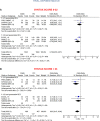Percutaneous vs. surgical revascularization for patients with unprotected left main stenosis: a meta-analysis of 5-year follow-up randomized controlled trials
- PMID: 32392283
- PMCID: PMC8686114
- DOI: 10.1093/ehjqcco/qcaa041
Percutaneous vs. surgical revascularization for patients with unprotected left main stenosis: a meta-analysis of 5-year follow-up randomized controlled trials
Abstract
Aims: A 5-year survival of patients with unprotected left main (ULM) stenosis according to the choice of revascularization (percutaneous vs. surgical) remains to be defined.
Methods and results: Randomized controlled trials (RCTs) comparing percutaneous coronary intervention (PCI) vs. coronary artery bypass graft (CABG) with a follow-up of at least 5 years were included. All-cause death was the primary endpoint. MACCE [a composite endpoint of all-cause mortality, myocardial infarction (MI), stroke, and repeat revascularization] along with its single components and cardiovascular (CV) death were the secondary ones. Analyses were stratified according to the use of first- vs. last-generation coronary stents. Subgroup comparisons were performed according to SYNTAX score (below or above 33) and to age (using cut-offs of each trial's subgroup analysis). Four RCTs with 4394 patients were identified: 2197 were treated with CABG, 657 with first generation, and 1540 with last-generation stents. At 5-year rates of all-cause death did not differ [odds ratio (OR) 0.93, 95% confidence interval (CI) 0.71-1.21], as those of CV death and stroke. Coronary artery bypass graft reduced rates of MACCE (OR 0.69, 95% CI 0.60-0.79), mainly driven by MI (OR 0.48, 95% CI 0.36-0.65) and revascularization (OR 0.53, 95% CI 0.45-0.64). Benefit of CABG for MACCE was consistent, although with different extent, across values of SYNTAX score (OR 0.76, 95% CI 0.59-0.97 for values < 32 and OR 0.63, 95% CI 0.47-0.84 for values ≥ 33) while was not evident for 'younger' patients (OR 0.83, 95% CI 0.65-1.07 vs. OR 0.65, 95% CI 0.51-0.84 for 'older' patients).
Conclusion: For patients with ULM disease followed-up for 5 years, no significant difference was observed in all-cause and cardiovascular death between PCI and CABG. Coronary artery bypass graft reduced risk of MI, revascularization, and MACCE especially in older patients and in those with complex coronary disease and a high SYNTAX score.
Keywords: Coronary artery bypass graft; Coronary artery disease; Meta-analysis; Percutaneous coronary intervention; Unprotected left main.
Published on behalf of the European Society of Cardiology.
Figures





Similar articles
-
[Comparison on the long-term outcomes post percutaneous coronary intervention or coronary artery bypass grafting for bifurcation lesions in unprotected left main coronary artery].Zhonghua Xin Xue Guan Bing Za Zhi. 2017 Jan 25;45(1):19-25. doi: 10.3760/cma.j.issn.0253-3758.2017.01.005. Zhonghua Xin Xue Guan Bing Za Zhi. 2017. PMID: 28100341 Chinese.
-
Percutaneous Coronary Intervention vs Coronary Artery Bypass Grafting in Patients With Left Main Coronary Artery Stenosis: A Systematic Review and Meta-analysis.JAMA Cardiol. 2017 Oct 1;2(10):1079-1088. doi: 10.1001/jamacardio.2017.2895. JAMA Cardiol. 2017. PMID: 28903139 Free PMC article.
-
Percutaneous coronary intervention or coronary artery bypass graft in left main coronary artery disease: a comprehensive meta-analysis of adjusted observational studies and randomized controlled trials.J Cardiovasc Med (Hagerstown). 2018 Oct;19(10):554-563. doi: 10.2459/JCM.0000000000000703. J Cardiovasc Med (Hagerstown). 2018. PMID: 30095584 Review.
-
Coronary artery bypass grafting vs. percutaneous coronary intervention for patients with three-vessel disease: final five-year follow-up of the SYNTAX trial.Eur Heart J. 2014 Oct 21;35(40):2821-30. doi: 10.1093/eurheartj/ehu213. Epub 2014 May 21. Eur Heart J. 2014. PMID: 24849105 Clinical Trial.
-
Percutaneous coronary intervention or coronary artery bypass grafting for unprotected left main coronary artery disease.Catheter Cardiovasc Interv. 2017 Oct 1;90(4):541-552. doi: 10.1002/ccd.26970. Epub 2017 Mar 15. Catheter Cardiovasc Interv. 2017. PMID: 28296170 Review.
Cited by
-
Left Main Coronary Artery Disease-Current Management and Future Perspectives.J Clin Med. 2022 Sep 28;11(19):5745. doi: 10.3390/jcm11195745. J Clin Med. 2022. PMID: 36233613 Free PMC article. Review.
-
Prediction of All-Cause Mortality Following Percutaneous Coronary Intervention in Bifurcation Lesions Using Machine Learning Algorithms.J Pers Med. 2022 Jun 17;12(6):990. doi: 10.3390/jpm12060990. J Pers Med. 2022. PMID: 35743777 Free PMC article.
-
Long-Term Outcomes of Patients with Unprotected Left Main Coronary Artery Disease Treated with Percutaneous Angioplasty versus Bypass Grafting: A Meta-Analysis of Randomized Controlled Trials.J Clin Med. 2020 Jul 14;9(7):2231. doi: 10.3390/jcm9072231. J Clin Med. 2020. PMID: 32674522 Free PMC article. Review.
-
Quality of Life After Coronary Artery Bypass Surgery: A Systematic Review and Meta-Analysis.Int J Environ Res Public Health. 2020 Nov 14;17(22):8439. doi: 10.3390/ijerph17228439. Int J Environ Res Public Health. 2020. PMID: 33202650 Free PMC article.
-
[Clinical outcomes of percutaneous intervention on the unprotected left main coronary artery].Rev Med Inst Mex Seguro Soc. 2024 Jan 8;62(1):1-8. doi: 10.5281/zenodo.10278143. Rev Med Inst Mex Seguro Soc. 2024. PMID: 39110910 Free PMC article. Spanish.
References
-
- D'Ascenzo F, Presutti DG, Picardi E, Moretti C, Omedè P, Sciuto F et al. Prevalence and noninvasive predictors of left main or three-vessel coronary disease: evidence from a collaborative international meta-analysis including 22 740 patients. Heart 2012;98:914–919. - PubMed
-
- Yusuf S, Zucker D, Passamani E, Peduzzi P, Takaro T, Fisher LD et al. Effect of coronary artery bypass graft surgery on survival: overview of 10-year results from randomised trials by the Coronary Artery Bypass Graft Surgery Trialists collaboration. Lancet 1994;344:563–570. - PubMed
-
- Lee PH, Ahn J-M, Chang M, Baek S, Yoon S-H, Kang S-J et al. Left main coronary artery disease: secular trends in patient characteristics, treatments, and outcomes. J Am Coll Cardiol 2016;68:1233–1246. - PubMed
-
- Palmerini T, Serruys P, Kappetein AP et al. Clinical outcomes with percutaneous coronary revascularization vs coronary artery bypass grafting surgery in patients with unprotected left main coronary artery disease: a meta-analysis of 6 randomized trials and 4,686 patients. Am Heart J 2017;190:54–63. - PubMed
-
- Head SJ, Milojevic M, Daemen J, Ahn J-M, Boersma E, Christiansen EH et al. Mortality after coronary artery bypass grafting versus percutaneous coronary intervention with stenting for coronary artery disease: a pooled analysis of individual patient data. Lancet 2018;391:939–948. - PubMed
Publication types
MeSH terms
Grants and funding
LinkOut - more resources
Full Text Sources
Medical
Miscellaneous

